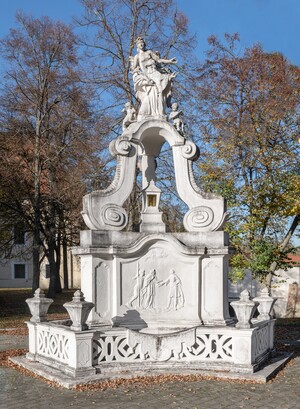St. John of Nepomuk as a “patron saint” of the Habsburgs in the age of Baroque Catholicism
In 2021, the 300th anniversary of the beatification of St. John of Nepomuk (c. 1350–1393) is celebrated. In the 18th century, the extraordinary veneration of this saint developed into a prime example of baroque veneration of saints due to its extraordinarily widespread effect and the fact that it reached nearly all social groups. Through countless public monuments, frescoes, altarpieces and prints, and the accompanying marginalisation of other saints, St. John became an almost ubiquitous figure of Baroque Catholicism.
On the occasion of the jubilee, the research project will explore questions regarding how the Bohemian martyr became a “patron saint” of the Habsburgs in the 18th century and what role the various image and text media played in this processes. The beatification and canonisation (1721 and 1729) of John of Nepomuk, promoted by the Bohemian elites, Emperor Charles VI and the Jesuits, legitimised pre-existing traditions of veneration and promoted new forms of the cult. Due to various factors, some of which were of supra-regional relevance (the saint’s devotion to Mary), the veneration taken up by the ruling dynasty proved to have an astonishingly high potential for integration almost throughout the entire Habsburg dominion as well as the Holy Roman Empire.
As a preacher who protected the secrecy of confession, Saint John of Nepomuk embodied the ideal of the Catholic priest, a notion reinforced by the mostly uniform manner and costume in which he was represented. At the same time, his halo of stars and his tongue are characteristic saintly attributes that contributed to his unique profile. Hence the project examines various developments of the forming of images and its typology in public monuments and church decors. Moreover, the study also focuses sermons dealing with St. John of Nepomuk in order to provide qualitative and quantitative strategies of his appropriation by various orders and the role played by preachers and the sites of their sermons. We further examine the relationships between the content of these sermons and visual media.
The research project pays particular attention to the latent tension between the regional and transregional appropriations of this saint as well as his multiple functions as a patron saint of the Habsburgs and the Wittelsbach dynasty and as a prominent patron saint of Bohemia. The declared aim of the project is to close the striking research gap that currently exists on the dynastic exploitation of St. John of Nepomuk in order to develop the basis for a differentiated sacral topography of Eastern Austria in the 18th century.
The results of this project have been published in a comprehensive anthology (2022) under the title “The veneration of St. John of Nepomuk in Eastern Austria. The cult of the Saint between piety practice and medialisation“ (Studien und Forschungen aus dem Niederösterreichischen Institut für Landeskunde, vol. 78).
The publication of the 2021 international conference appeared 2023 under the title “Johannes von Nepomuk: Kult – Künste – Kommunikation”, edited by Ramona Hocker and Werner Telesko (Vienna: Hollitzer).
Project leader
Staff
Dr. Stefanie Linsboth (January 2020 - November 2021)
Dr. Sabine Miesgang (from February 2022 onwards)
Project term
January 2020 – July 2022
Funding
Anniversary Fund of the Oesterreichische Nationalbank


